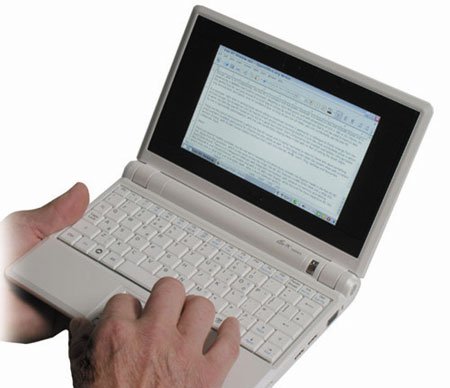Computer makers have always advertised notebooks as
”
portable,
”
a technically accurate but highly misleading word for their
back-breaking products.
Andrew D. Smith – The Dallas Morning News
DALLAS
Computer makers have always advertised notebooks as “portable,” a technically accurate but highly misleading word for their back-breaking products.
Now they’re flooding the market with something different: portable computers that actually are portable.
Better still, manufacturers have taken two different approaches to cut size and weight. One uses cutting-edge technology to put traditional notebooks on a diet and create powerful-but-expensive “slimbooks.” The other removes needless components and software to make tiny “netbook” computers that can cost less than $300.
Apple brought the first slimbook to market in January with its MacBook Air. The device packs a 13.3-inch screen and a full-size keyboard into a three-pound package. A 15-inch Macbook Pro, by contrast, weighs 5.5 pounds and ranks among the lightest full-size notebooks.
Less than a month after the MacBook Air debuted, Lenovo began selling a similar device, the ThinkPad X300.
Hewlett-Packard then announced plans for its Voodoo Envy 133 and Toshiba unveiled the Portege R500, a 12-inch device that will weigh just 2.4 pounds.
Folks who never take their notebooks farther than the living room may question the importance of a measly two or three pounds. Road warriors know to forget about pounds. Every ounce counts.
And weight isn’t the only slimbook advantage. Their small chips and LED screens extend battery life. Some have solid state drives, which use less energy than spinning-disk hard drives.
The MacBook Air runs roughly five hours on its tiny battery, about as much as the MacBook Pro runs on a much larger model.
One X300 model goes a step further. It substitutes a second battery for the DVD drive and lasts seven hours on a single charge.
In a couple of years, slimbook users will work all day without needing to lug power bricks or search for plugs.
“Notebook users, traditionally, have sacrificed battery life to cut weight or boost computing power,” said Leslie Fiering, lead notebook analyst at Gartner Research.
“But we may be near the point where we can get all-day use from a light, powerful notebook, and it’s going to be incredibly liberating for road warriors.”
We’re not quite there yet, though.
All slimbooks sacrifice performance for portability. Chips are slow. Storage is limited. Some models omit DVD drives and skimp on ports.
But manufacturers doubt these shortcomings will much deter the business users who buy high-end notebooks. E-mail programs, Office software and Internet browsers don’t require much storage or computing power.
At the low end, mini notebooks go much further with the feature cutting. Rather than trying to replicate a full-size computer on a smaller scale, some of these “netbooks” offer little more than a quick way to get online.
The Asus Eee, which basically invented the netbook category when it hit stores last fall, uses a streamlined Linux operating system rather than Windows. It includes little software. It doesn’t have a DVD drive either – or even a traditional hard drive.
The dearth of features allows the computer to boot up in about 20 seconds and lets Asus sell it for $299. Its 7-inch screen and miniature body keep the weight down to just two pounds.
Some consumers may ask what they could do on a computer that lacks both software and storage. The surprising answer: almost everything.
Internet-based software now lets anyone with a Web browser check e-mail, type documents, make spreadsheets, create presentations, edit photos, manage finances or plan days.
Web-ware helped make the Eee a blockbuster hit and lured competitors into the netbook market.
Hewlett-Packard has launched a line of netbooks called Mini-Notes. Everex sells a model called the Cloudbook. Acer sells the Aspire One. Dell plans to join the fray soon with the Dell E.
In all, chipmaker Intel says, 10 manufacturers will bring 20 models to market by year’s end. It expects netbook sales to top 50 million a year by 2011.
Of course, many users still want notebooks with Windows, Word and a hard drive. Netbook makers oblige such folks with slower or pricier models.
Most offer Windows XP on some models. A few offer the larger Windows Vista operating system, which can slow netbooks to a crawl.
Options proliferate almost weekly, and the trend will probably continue.
“We’ll see more and more variety as the technology improves and prices keep falling,” said Harry Wang, a senior analyst at Parks Associates in Plano, Texas.
“People won’t have one or two computers. As prices fall, people may buy a handful and use each one for specific situations, just like they use certain shoes for exercise and others for work.”













